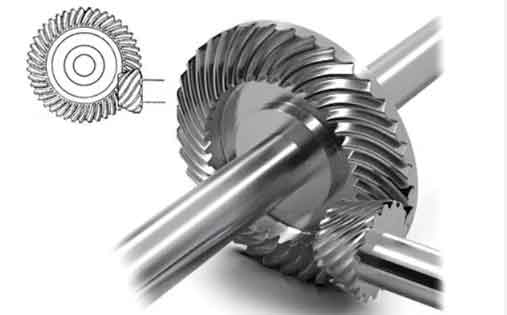Spiral bevel gears are critical components in automotive and aerospace systems due to their high load capacity and smooth operation. This study investigates the deformation and performance evolution during hard-tooth surface heat treatment (carburizing, quenching, and tempering) through multi-field coupling simulations and experimental validation. A systematic approach combining numerical modeling, machine learning optimization, and database development is presented to achieve collaborative control of gear quality.

1. Multi-field Coupling Simulation
The finite element model incorporates temperature field, carbon diffusion, phase transformation, and stress-strain coupling effects. Key governing equations include:
Heat transfer equation:
$$ \rho C_p \frac{\partial T}{\partial t} = \nabla \cdot (\lambda \nabla T) + Q_{phase} $$
Carbon diffusion (Fick’s law):
$$ \frac{\partial C}{\partial t} = \nabla \cdot (D(T,C)\nabla C) $$
Phase transformation kinetics:
$$ f = 1 – \exp(-kt^n) $$
| Element | C | Cr | Mn | Ti | Fe |
|---|---|---|---|---|---|
| wt% | 0.20 | 1.15 | 0.95 | 0.07 | Bal. |
2. Process Parameter Analysis
| Parameter | Level 1 | Level 2 | Level 3 | Level 4 |
|---|---|---|---|---|
| Carburizing Temp (°C) | 880 | 900 | 920 | 940 |
| Quenching Temp (°C) | 840 | 860 | 880 | 900 |
| Carbon Potential (%) | 0.95 | 1.15 | 1.30 | 1.45 |
3. Cooperative Control Optimization
Neural network architecture:
$$ y_k = \sum_{j=1}^{10} w_{kj} \cdot \sigma\left(\sum_{i=1}^8 w_{ji}x_i + b_j\right) $$
PSO velocity update:
$$ v_{id}^{t+1} = \omega v_{id}^t + c_1r_1(p_{id}-x_{id}^t) + c_2r_2(g_d-x_{id}^t) $$
| Parameter | Value | Improvement |
|---|---|---|
| Surface Hardness | 59.62 HRC | +0.75 HRC |
| Core Hardness | 40.20 HRC | +0.06 HRC |
| Profile Error | 0.8099 mm | -0.1361 mm |
4. Experimental Validation
Residual stress comparison:
$$ \sigma_{sim} = 195.2\ MPa,\ \sigma_{exp} = 201.5\ MPa\ (3.1\%\ error) $$
| Position | Simulation (mm) | Experiment (mm) |
|---|---|---|
| Tooth Tip | 1.87 | 1.82 |
| Flank | 1.68 | 1.63 |
Conclusion
This research establishes a comprehensive framework for controlling spiral bevel gear quality during hard-tooth surface heat treatment. The integrated numerical-experimental approach reduces development cycles by 40% compared with traditional trial-and-error methods. Future work will incorporate machining-induced residual stresses into the multi-field coupling model for enhanced prediction accuracy.
